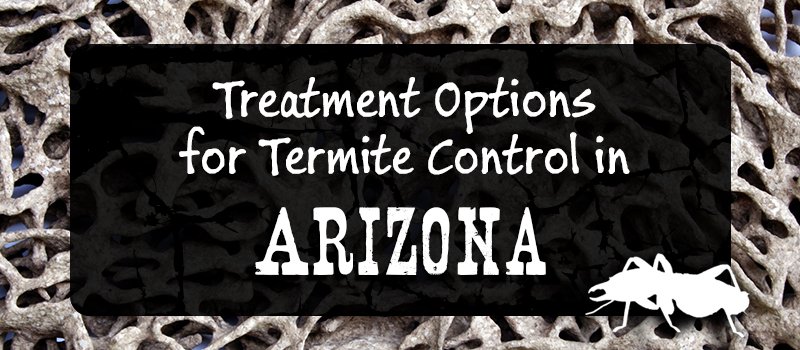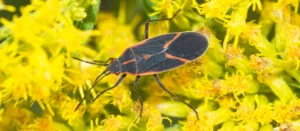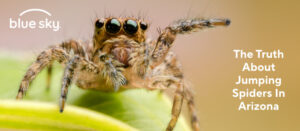$50 OFF New Residential Customers. Learn more
Treatment Options for Termite Control in Arizona

Termites are extremely common throughout the greater Phoenix area. Every day, we treat homes with termite infestations. The most common termite we work with—about 98% of the time—is the Heterotermes, or desert subterranean termite.
There are generally two approaches one can take to address this type of termite activity for a home or business: liquid treatment or baiting.
If you live in the Phoenix area and need termite pest control, we can help you! We serve the entire metro area from our Phoenix and Gilbert offices including Tempe, San Tan Valley, Peoria, and Glendale.
Liquid Treatments—the Most Common Treatment Approach
-
- How do Liquid Treatments Work
A liquid treatment involves digging a two- to six-inch deep by four- to six-inch wide trench around the foundation of the home. Where there is concrete abutting the foundation, holes are drilled into the concrete to get to the soil underneath the concrete or pavers, unless it is a post-tension slab. The chosen material is then placed into the trench or injected under the slab through the drill holes. The material will travel into the soil to target the termites, since that is where the desert subterranean termite comes from.
-
- Effectiveness of Liquid Treatments
The effectiveness of liquid treatments is determined by the type of material chosen and how the treatment is applied by the pest management professional. Non-repellants are the best materials to use as they cannot be detected by the termites. With non-repellants, the termites unknowingly get into the material and share it within the colony. This liquid treatment leaves a residual that can effectively protect a home from termite activity for a period of several years after treatment.
Baiting Treatments
-
-
How Baiting Treatment Works
-
Bait monitoring stations are installed in the soil around the home using a drill or auger, spaced about every ten to 20 feet. These bait stations have an area in which to put a cellulose material, which is then available to the termites underground. This material can include an active ingredient or simply be the cellulose material, which has no attractant; the termites have to find the material. After being placed, these monitoring stations are inspected to determine if they are “hit.” If using cellulose material only, the active ingredient needs to then be added to the stations.
-
-
Effectiveness of Baiting Treatments
-
The Heterotermes desert subterranean termite is a sensitive little creature to what is called “disturbance.” Studies have shown that when something around them is disturbed, the termites tend to stay away for a time. So what does this have to do with baiting?
Previous systems required the pest management professional to take the interior tube that held the cellulose out of the station to inspect the system to see if there was activity. In addition, when a hit occurred, this material was swapped out for bait that had an active ingredient that would actually eliminate the colony. In each of the scenarios, disturbance occurs; this is one of the factors as to why baiting systems have had trouble in the Phoenix area.
In other areas of the country where different species of termites live, baiting systems have proved to be very effective. BASF, a chemicals company, has had a product on the market for some time called the Advance Termite Bait System (ATBS). This system does not require the pest management professional to disturb the cellulose within the cylinder in the ground. Once termite activity is experienced, he or she simply places the active ingredient on the top of the cellulose. This approach reduces the likelihood of disturbance. Dow, another chemicals company, has also recently introduced a similar approach with its widely used Sentricon system. This new approach allows the pest management professional to avoid disturbing the cellulose at all.
In addition to disturbance, research has been done that identifies other factors that may affect the effectiveness of baiting systems. The size of the termite colony we deal with most often in the Phoenix area ranges between 100,000 to 450,000 termites. Other species, like the Eastern subterranean termite, have colonies that can reach numbers greater than one million. Smaller colonies may reduce the likelihood of finding the baits. In some instances, not enough bait monitoring stations are placed at the customer’s home in order to reduce the cost of the baiting system and continual monitoring. Current research is not conclusive, but there is the possibility that because the colony sizes are smaller, the termites that come into contact with the active material may not bring a sufficient quantity of it back to the colony to be effective.
There are advances being made with the baiting systems, and we are currently in the look and see phase to determine if these new advances will provide the consistency and predictability of results we promise our customers. We provide termite control throughout the Phoenix area including Gilbert, Surprise, Mesa, and Scottsdale! Get your free quote today!
Related Posts

Killer Bees in Arizona? Understanding Africanized Bees and How to Coexist Safely
You’ve likely heard the term “killer bees” used to describe Africanized bees in Arizona, but did you know this nickname…

Red & Black Intruders: Meet Arizona’s Boxelder Bugs
Boxelder Bugs in Arizona If you’ve ever stepped outside and spotted a cluster of black-and-red bugs crawling on your porch…

Jumping Spiders in Arizona: Harmless or Hazardous?
Jumping spiders in Arizona might be small, but they can sure give you a big surprise when they suddenly appear…